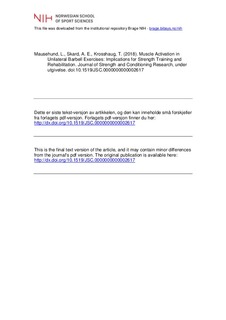| dc.contributor.author | Mausehund, Lasse | |
| dc.contributor.author | Skard, Audun Eithun | |
| dc.contributor.author | Krosshaug, Tron | |
| dc.date.accessioned | 2019-06-27T10:57:01Z | |
| dc.date.available | 2019-06-27T10:57:01Z | |
| dc.date.created | 2018-09-28T13:52:07Z | |
| dc.date.issued | 2018 | |
| dc.identifier.citation | Journal of Strength and Conditioning Research. 2018, under utgivelse. doi:10.1519/JSC.0000000000002617 | nb_NO |
| dc.identifier.issn | 1064-8011 | |
| dc.identifier.uri | http://hdl.handle.net/11250/2602541 | |
| dc.description | I Brage finner du siste tekst-versjon av artikkelen, og den kan inneholde ubetydelige forskjeller fra forlagets pdf-versjon. Forlagets pdf-versjon finner du på lww.com / In Brage you'll find the final text version of the article, and it may contain insignificant differences from the journal's pdf version. The definitive version is available at lww.com | nb_NO |
| dc.description.abstract | The purpose of the present investigation was to assess lower-body muscle activity and hamstrings-to-quadriceps (HQ) activation ratios during performance of the split squat (SS), single-leg squat (SLS), and rear foot elevated split squat (RFESS), while using the same relative load and performing the exercises to muscular failure. Eleven healthy, moderately strength-trained subjects performed a 6–8 repetition maximum set of each exercise while electromyographic (EMG) activity of the vastus lateralis, biceps femoris, gluteus maximus, and gluteus medius was recorded. The results show that there were no significant differences in EMG peak activity of the gluteus maximus and vastus lateralis between any of the exercises. Gluteus medius activation was significantly (p # 0.05) higher during the SLS (81.9% maximum voluntary isometric contraction [MVIC]), compared with the RFESS (54.9% MVIC) and SS (46.2% MVIC). The RFESS elicited higher (p # 0.05) biceps femoris activity (76.1% MVIC) than the SS (62.3% MVIC), as well as higher (p # 0.05) HQ activation ratios (0.83) than the SS (0.69) and SLS (0.63). During the SLS and the SS, HQ activation ratios increased significantly in the course of the repetition maximum set. In conclusion, although absolute loading differs between exercises, similar training stimuli of the gluteus maximus and quadriceps femoris can be expected for all exercises. The SLS is likely to induce the greatest improvements in gluteus medius strength, whereas the RFESS should be preferred if high hamstring coactivation is desired. To improve validity in EMG studies, strength training exercises should be performed close to failure while using the same relative loading. | nb_NO |
| dc.language.iso | eng | nb_NO |
| dc.relation.uri | https://www.klokavskade.no/globalassets/publications/mausehund_2018_nscr_muscle-activiation-in-unilateral-barbell-exercises.pdf | |
| dc.subject | electromyography | nb_NO |
| dc.subject | EMG | nb_NO |
| dc.subject | split squat | nb_NO |
| dc.subject | single-leg squat | nb_NO |
| dc.subject | Bulgarian lunge | nb_NO |
| dc.title | Muscle Activation in Unilateral Barbell Exercises: Implications for Strength Training and Rehabilitation | nb_NO |
| dc.type | Journal article | nb_NO |
| dc.type | Peer reviewed | nb_NO |
| dc.description.version | publishedVersion | nb_NO |
| dc.source.pagenumber | 10 | nb_NO |
| dc.source.journal | Journal of Strength and Conditioning Research | nb_NO |
| dc.identifier.doi | 10.1519/JSC.0000000000002617 | |
| dc.identifier.cristin | 1615768 | |
| dc.description.localcode | Seksjon for idrettsmedisinske fag / Department of Sports Medicine | nb_NO |
| cristin.unitcode | 150,34,0,0 | |
| cristin.unitname | Seksjon for idrettsmedisinske fag | |
| cristin.ispublished | true | |
| cristin.fulltext | original | |
| cristin.qualitycode | 1 | |
